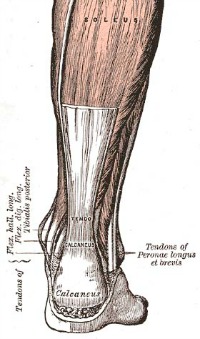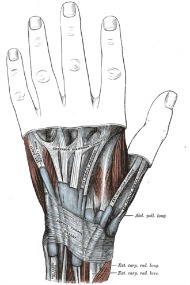Symptoms Of Tendonitis
The Navigation Bar to your left has Do-It-Yourself-Joint-Pain-Relief for every single joint in your body and the Site Map page lists every single page on this website.
Symptoms Of Tendonitis Explained

Some tendons are very long, like the tendons in your forearm a that go from the big muscles in your forearms all the way down to the bones in your hand. Some are very thick like your achilles tendon that goes from your calf muscles in the back of your leg attaches to your heel. But all tendons allow us to move (or stabilize) ourselves when the muscle flexes by being attached to our bones.
Tendonitis is just the inflammation of a tendon, usually where it attaches to the bone. Sometimes it's from the tendon being overloaded and damaged from one particular event. But most of the time in our modern culture tendonitis tends to occur from the repetitive use of a particular muscle.
Modern living requires a lot more repetitive motions with our bodies, both in our work and in our sports/exercise, than our bodies are prepared for. The tendon gets inflamed from being overworked and the muscle it's attached to tends to get tighter from being overworked. Thus, with the muscle remaining tight, it constantly pulls on the tendon even when not being used, so the tendonitis often doesn't go away.
The symptoms of tendonitis are varied. Some people will experience pain only when they go to use the muscle and tendon that is inflamed in a certain motion. Some will experience a weakness as they do certain motions that previously were done easily. Some will experience a stiffness in the joint that can increase of over time if the tendonitis is not treated. Some will experience a "dull ache" even when not using the muscle and tendon. There can be swelling in the area of the tendon as well.
Lastly, sometimes the tendon or surrounding area will be painful to touch. And this is important because the way you can often fix your own tendonitis symptoms is finding the areas are painful when you press on them and getting the tissue to release.
You Can Most Likely Fix Your Symtoms Of Tendonitis All By Yourself

This completely free website is dedicated to showing you how to release your tight tissue, so you can relieve your own pain.
To the left is the Navigation Bar that lists every joint in your body, so just pick the area that hurts in your body, click on the link, and follow along with the free videos.
At the top of the Navigation Bar is a link to the Site Map page, where are even more pain relief pages listed for each joint in your body.
So dive and and get to work on yourself. YOU CAN DO IT! You can set yourself free from pain.
Return From This Symptoms of Tendonitis Page
To The Do-It-Yourself Joint Pain Relief Homepage
This Free Pain Relief Website
By Clicking On Your Favorite Icon Below:
Add Gary Crowley to your Google Plus Circles -
Google+ (click here)
Copyright © 2011 - 2022 DiyJointPainRelief.com


